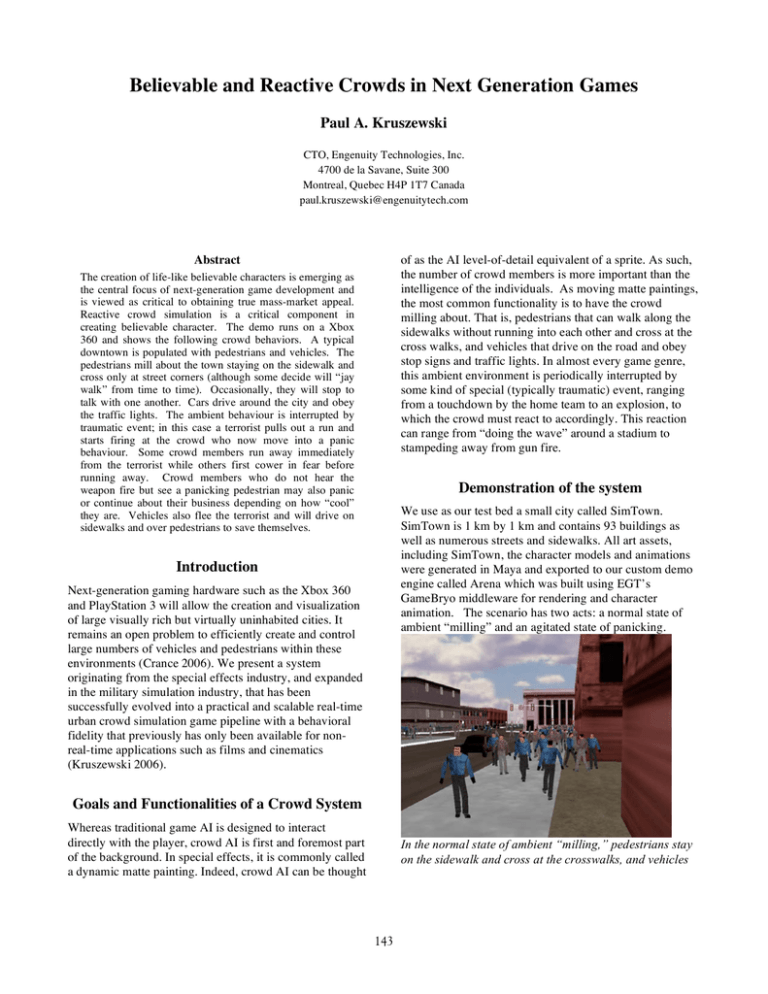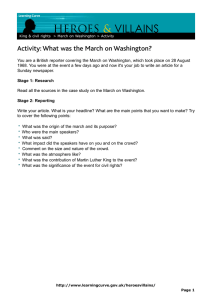
Believable and Reactive Crowds in Next Generation Games
Paul A. Kruszewski
CTO, Engenuity Technologies, Inc.
4700 de la Savane, Suite 300
Montreal, Quebec H4P 1T7 Canada
paul.kruszewski@engenuitytech.com
of as the AI level-of-detail equivalent of a sprite. As such,
the number of crowd members is more important than the
intelligence of the individuals. As moving matte paintings,
the most common functionality is to have the crowd
milling about. That is, pedestrians that can walk along the
sidewalks without running into each other and cross at the
cross walks, and vehicles that drive on the road and obey
stop signs and traffic lights. In almost every game genre,
this ambient environment is periodically interrupted by
some kind of special (typically traumatic) event, ranging
from a touchdown by the home team to an explosion, to
which the crowd must react to accordingly. This reaction
can range from “doing the wave” around a stadium to
stampeding away from gun fire.
Abstract
The creation of life-like believable characters is emerging as
the central focus of next-generation game development and
is viewed as critical to obtaining true mass-market appeal.
Reactive crowd simulation is a critical component in
creating believable character. The demo runs on a Xbox
360 and shows the following crowd behaviors. A typical
downtown is populated with pedestrians and vehicles. The
pedestrians mill about the town staying on the sidewalk and
cross only at street corners (although some decide will “jay
walk” from time to time). Occasionally, they will stop to
talk with one another. Cars drive around the city and obey
the traffic lights. The ambient behaviour is interrupted by
traumatic event; in this case a terrorist pulls out a run and
starts firing at the crowd who now move into a panic
behaviour. Some crowd members run away immediately
from the terrorist while others first cower in fear before
running away. Crowd members who do not hear the
weapon fire but see a panicking pedestrian may also panic
or continue about their business depending on how “cool”
they are. Vehicles also flee the terrorist and will drive on
sidewalks and over pedestrians to save themselves.
Demonstration of the system
We use as our test bed a small city called SimTown.
SimTown is 1 km by 1 km and contains 93 buildings as
well as numerous streets and sidewalks. All art assets,
including SimTown, the character models and animations
were generated in Maya and exported to our custom demo
engine called Arena which was built using EGT’s
GameBryo middleware for rendering and character
animation. The scenario has two acts: a normal state of
ambient “milling” and an agitated state of panicking.
Introduction
Next-generation gaming hardware such as the Xbox 360
and PlayStation 3 will allow the creation and visualization
of large visually rich but virtually uninhabited cities. It
remains an open problem to efficiently create and control
large numbers of vehicles and pedestrians within these
environments (Crance 2006). We present a system
originating from the special effects industry, and expanded
in the military simulation industry, that has been
successfully evolved into a practical and scalable real-time
urban crowd simulation game pipeline with a behavioral
fidelity that previously has only been available for nonreal-time applications such as films and cinematics
(Kruszewski 2006).
Goals and Functionalities of a Crowd System
Whereas traditional game AI is designed to interact
directly with the player, crowd AI is first and foremost part
of the background. In special effects, it is commonly called
a dynamic matte painting. Indeed, crowd AI can be thought
In the normal state of ambient “milling,” pedestrians stay
on the sidewalk and cross at the crosswalks, and vehicles
143
stay on the road and obey traffic lights.
Transition from the normal state to the panic state is caused
by a “traumatic event,” in this case a gun being fired in a
crowded street.
intersection. Once it has cleared the intersection, it returns
the ticket back to the traffic cop. This ticketing system
allows for irregular stop sign configurations such as threeway stops.
People milling about on sidewalks. Just as cityscapes are
full of cars driving around, people mill about on sidewalks,
crossing at cross walks. Since the movement along a
sidewalk is significantly less delineated than a street, it is
more appropriate to use a navmesh for navigation. Similar
to a driver, a pedestrian will choose a destination at
random. The pedestrian uses the navmesh to find a path
between itself and the destination that only involves only
sidewalk or crosswalk cells. Once it arrives at the
destination, it chooses a new destination. Collision
avoidance prevents pedestrians from running into each
other. Blind data restricts street crossing to crosswalks.
Vision sensors and decision trees prevent pedestrians from
crossing against the traffic lights.
In the agitated state of “panicking,” pedestrians run
away from the traumatic event (a terrorist firing a
weapon) and will run across street while trying to avoid
collisions with other pedestrians and vehicles.
Agitated Panicking State
In our example, a terrorist can be controlled to walk around
the crowd. The user can trigger the terrorist to pull out his
weapon and start firing. At this point, the terrorist puts
himself into group of agitated characters. A crowd member
will go into the agitated state if he sees any members in the
agitated group nearby. This technique causes the panic to
ripple outwards from the terrorist towards crowd members
who do not directly see the terrorist. When a crowd
member goes into the agitated state, it chooses a new target
destination that takes away from the traumatic object. The
pathfinder now ignores blind data and chooses the shortest
path, thereby potentially causing the crowd member to
cross the street.
Normal Milling State
In this example, we want to simulate normal traffic in a
busy city of cars driving around and people walking about.
Vehicles obeying traffic rules. We simulate the vehicle
driver by an autonomous character that controls the
position and orientation of the vehicle model. To generate
traffic circulation, each driver chooses a random
destination from a set of pre-assigned waypoints. This has
the added advantage of allowing the level editor to directly
control the distribution of the traffic within the city. The
road network is represented by a waypoint graph. The
driver uses it to find a path between itself and its
destination. Once it arrives at the destination, it chooses a
new destination. The directed edges of the waypoint
network ensure that that the cars stay in their lanes.
References
Crane, S., “Bringing Game Characters to Life,” Journal of
Game Development V1(3), Charles River Media, 2006: pp.
51 – 61.
In order for cars not to rear-end one another, decision
making logic must be added to allow them to sense other
vehicles. When a vehicle ahead is being approached, the
car slows down via queuing collision avoidance. Collisions
at intersections are avoided in by implementing stop signs
and traffic lights. Each traffic light is implemented as an
autonomous character that cycles through the states of
green, yellow and red. Each driver has a traffic light sensor
that allows it to see the traffic light’s state. If the driver
sees a red light and it is near a stop point, it will stop. Stop
points are located just before crosswalks. Cars behind the
first stopping car stop due to queuing collision avoidance.
When a driver sees a stop sign, it will go directly to the
stop point in the street. There it will ask an invisible traffic
cop for a ticket to pass through the intersection. When its
ticket becomes active, it will proceed through the
Kruszewski, P., “Real-time Crowd Simulation Using
AI.implant,” AI Game Programming Wisdom 3, Charles
River Media, 2006: pp. 233 – 248.
Acknowledgements
The AI.implant system is the result of many years of hard
teamwork. The author would like to thank the entire
AI.implant development team at ETI for its ongoing
excellent work, and in particular Cory Kumm who
developed the .ACXs and artwork. Copyright © 2006,
American Association for Artificial Intelligence. All rights
reserved.
144


